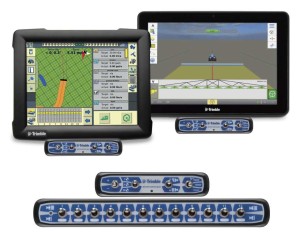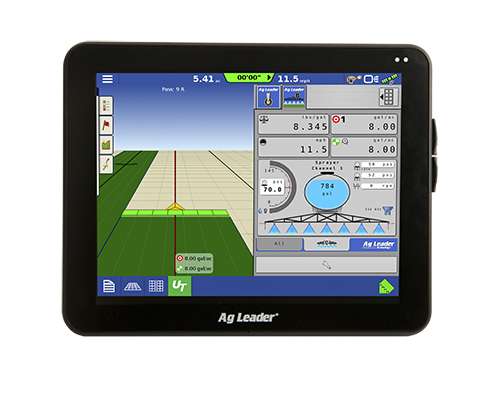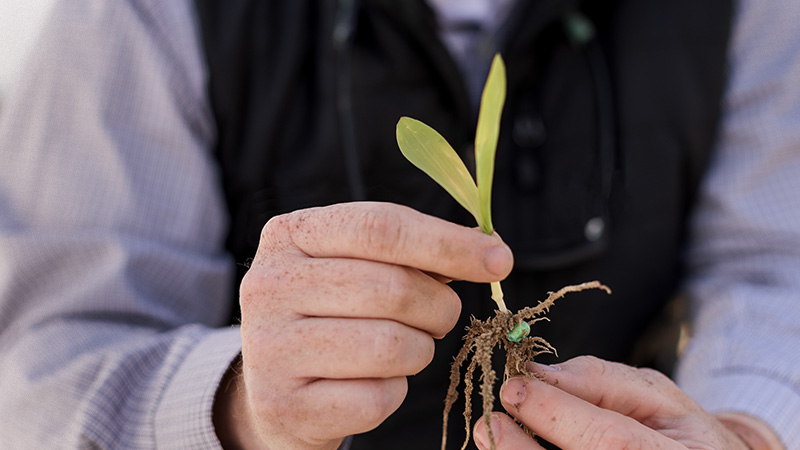Rate Controllers Tied To More Precision Tasks
Rate controllers reduce input costs — bottom line — and every grower is looking for ways to decrease seed and chemical costs while maintaining maximum yield, says T.J. Schulte, market manager for Trimble’s Agriculture Division.
“Customers will continue to buy more advanced rate controllers as long as they are convinced the return on investment is beneficial for their business.”

Examples of Trimble’s FmX.
Manufacturers are addressing some of the buying issues users face when trying to get the best units for their needs. Several companies we spoke with agreed that one of the biggest challenges is finding controllers that will work across a diverse fleet of machines.
“Users with mixed fleets or multiple types of equipment with variable-rate swath widths or number of sections need a system that works with any brand and is simple to set up,” says Alex Lundgren, product sales specialist with Ag Leader.
In fact, one of the biggest developments recently is the number of precision components that are becoming ISOBUS compatible. The new generation of Ag Leader’s DirectCommand rate controllers includes the ISOBUS Liquid Control Module and the ISOBUS Serial Application Rate Module, Lundgren says. New enhancements provide greater overall system control and critical system information visibility, as well as accommodate for today’s increasingly sophisticated application equipment including support of additional boom sections, wider variety of control valves, flow meters, temperature sensors, and pressure sensors.
TeeJet is continuing to integrate ISOBUS capability/compatibility into several models of its control and monitoring systems. “This allows our controls to be ‘plug and play’ compatible with ISOBUS equipped machines and third-party control,” says Tim Stuenkel, global marketing communications manager. “It also allows users to enjoy a less cluttered cab, more consistent user interface and reduced cost of adding new technology to their machines.”
AgJunction just released its Advanced Task Controller, which allows for control on most ISOBUS-capable equipment without the need for another terminal in the cab. It ties to the company’s Virtual Terminal feature on the Outback MAX display for implement control — including automatic section control and rate control on planters and seeders.
Topcon’s new Apollo Sprayer ECU (electronic control unit) supports ISO Can messages as well as the Topcon Horizon user interface. A multi-channel control unit that Harlan Little, product manager, precision agriculture applications, says “is the next generation of ECU,” it connects to sensors and valves to control the actual rate and section control. “It can be retro-fitted and will be a welcome piece to an OEM looking for a simple, reliable control unit,” he adds.
“Each manufacturer has a slightly different strategy on how their control systems are developed,” says Cody Light, senior marketing specialist with AGCO. “This can often lead to challenges that the operator faces and the need for multiple user interfaces to learn.” He says that AGCO is continuing to make a strong investment in ISOBUS technology — which will offer an open approach to work with the company’s and other products in the marketplace.
“Our rate control systems are becoming more and more embedded into the machines that AGCO produces today. This has made them easier to use and more accurate,” Light says.
Indeed, ISOBUS capability lends itself to the one thing Raven Industries’ Ryan Molitor, marketing and business development operations manager, believes buyers are looking for: Simplicity. “Our customers love the technology and all the bells and whistles, but it has to be simple,” he says. “It is hard to put an ROI on reduced operator fatigue, but the operator in the cab knows the positive impact in developing technology that makes their day a lot less stressful.”
Because of integration and complexity issues, Molitor says Raven stresses the need to design products that are not only innovative, but also simple.
Raven’s new Hawkeye nozzle control system integrates flow and pressure control into one system. “This reduces cab clutter, but also provides for more accurate as-applied data. The system ensures the proper application of chemicals regardless of speed, machine movements, and varying headlands,” says Molitor. Plus, integrating the rate controller into the field computer in the cab has also helped with recordkeeping, invoicing, and data management.
Monitoring, Data
Design simplicity can be a challenge in part because controllers are now acting on instructions based on new levels of monitored information and data.

The InCommand display improves real-time decision-making with features such as enhanced mapping with row-by-row detail and split screen view, which will allow users to identify machine control issues earlier and easier.
This fall, Ag Leader debuted its InCommand display line-up, which includes the InCommand 1200 and InCommand 800. The InCommand display improves real-time decision-making with features such as enhanced mapping with row-by-row detail and split screen view, which will allow users to identify machine control issues earlier and easier.
He adds that Ag Leader has added many features to its new generation DirectCommand rate controller such as droplet size monitoring, pressure fallback, anhydrous ammonia liquid state monitoring and ISOBUS compatibility. For instance, monitoring droplet size is important to ensure proper plant coverage. The DirectCommand rate controller provides this real-time monitoring based on current system pressure with an easy to use interface and dynamic color-coded pressure gauge.
In fact, precise monitoring of what’s going on during application — and adjusting controllers accordingly — has become a new high standard.
TeeJet has been able to bring several new technologies to the market in recent years, including droplet size monitoring. Tip flow monitoring technology allows operator to monitor flow rate to individual nozzles on sprayers or metering orifices on planters/fertilizer toolbars. “Being able to immediately detect and correct flow issues during application is not easy to do without a monitoring system,” says Stuenkel. “And the cost savings due to improved pest control and/or improved yield can be significant.”
TeeJet’s DynaJet Flex 7120 nozzle control system can control droplet size and flow rate independently of pressure. This ensures that the crop protection product being applied achieves proper coverage and optimal control while minimizing off-target application which can of course, have significant implications.
Looking Ahead
These more responsive technologies are a help not only in the current environment of herbicide resistance, but will be an important tool as new herbicide systems come to market. Manufacturers agreed that the use of new generation herbicide-tolerant crops (such as dicamba- and 2,4-D-resistant varieties) present the need and opportunity to become better managers of spray application by ensuring proper coverage and minimizing drift.
Also ahead, Ag Leader’s Lundgren sees the need for rate controllers to have ever more advanced functions. “As regulation on product application becomes more stringent, both in the U.S. and abroad, rate controllers must become more precise and offer improved resolution and product control,” he says.
Connectivity between field and office will continue to help move and manage the valuable data the controller or field computer is collecting and using, says Raven’s Molitor. “This will make them more efficient, reducing the amount of inputs and the input costs associated with application.”
Topcon’s Little adds connectivity “made easy” is coming. The company is leveraging existing systems to build the Mobile Ag Network that allows constant connection and data transfer from the X-Family of consoles. “We will continue to add more connectivity to allow other devices so the Mobile Ag Network can be the portal for all data transferred to and from the machines involved in farming operations,” he says.
AGCO’s Light says AGCO will be introducing new Fuse technologies that will allow operators more uptime and reliability. They’ll align with the Fuse open farm approach, which provides mixed-fleet farming operations improved access to their farm data.
Rate controllers will also play a more important role in the data mix. “Customers are consuming huge amounts of data when making planting decisions as well as flow and application control decisions,” says Trimble’s Schulte. He sees crop health sensors becoming a larger part of the decision-making process. The information they supply as well as variables such soil type, water retention, seed varieties, weather, vehicle speed, regional practices — the list is almost endless — will impact the work of rate controllers more.
“Let’s not forget traceability,” Little says. “Most custom applicators and larger growers know that traceability of chemicals, particularly for sprayers, is likely to be inevitable in the coming years. Investing in controllers that have traceability baked into their software from the beginning should be a critical buying decision factor.”





